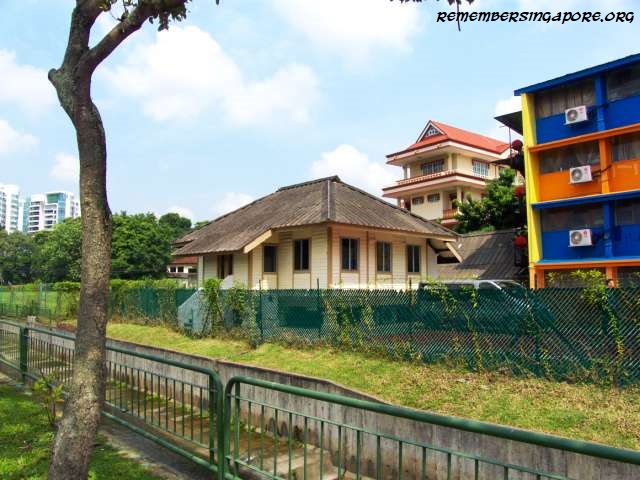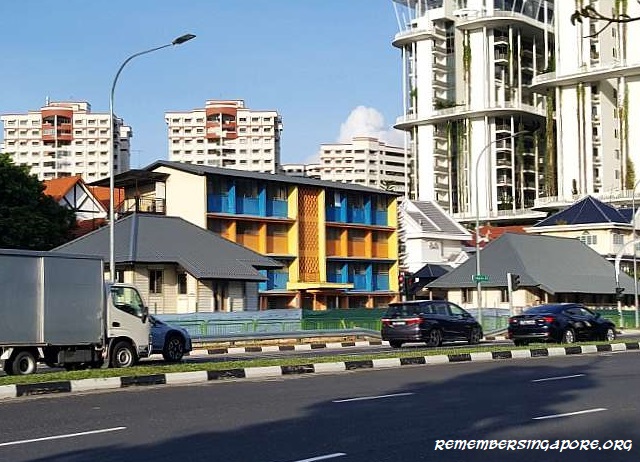There are a couple of old buildings along Tampines Road, near its junction with Upper Serangoon Road, that seem out of place standing among the new developments in the vicinity. They were the former Customs Station and Quarters, more than three decades ago, functioning under the jurisdiction of the Customs Operations Command Building, or COC, at Keppel Road.

Prior to that, during the Second World War, the wooden houses were apparently warehouses storing gunny bags of rice. After the Customs Station’s operations ceased in the seventies, the buildings were utilised as an Islamic religious school for several years during the nineties. They were then converted into a kindergarten and student hostel in the 2000s.
Today, the vacant buildings, consisting of five single-storey wooden houses and a four-storey block, stand between new private condominiums Tembusu and Stars of Kovan (still under construction). The buildings are part of the list of state properties under the administration of the Singapore Land Authority (SLA).


The COC, during the sixties and seventies, was the headquarters of the Land Division of the Customs and Excise Department. Beside the Tampines Road Customs Station, it also held the jurisdiction of other Customs Stations located at the old Woodlands Customs Checkpoint, Kangkar, Lim Chu Kang, Changi, Tanjong Pagar and Jurong, which was its latest addition in the seventies.
A customs team, known as the Land Squads, was stationed at the Land Division headquarters, with specific tasks to raid and seize the illegal manufactured samsoo, or samsu (which like toddy, was a type of alcoholic drink once popular among the local community in Singapore and Malaysia), smuggled opium and duty unpaid cigarettes.


The Land Squads was organised into “A”, “B” and “B” teams, with each teams assigned to their designated zones of duty. Often, the teams had to venture into the rural parts to seek the hidden samsoo distilleries and smugglers hidden in the jungles. In 1964, the customs officers busted an illegal samsoo hideout in the thick undergrowth along Tampines Road. Caught with almost 1,800 litres of mash and 80 litres of samsoo, the manufacturer was fined a hefty $9,000.
The Customs Stations at Changi, Kangkar and Tampines Road came with staff quarters that provided accommodation for the customs personnel. The customs officers stationed at Tampines Road Customs Station were tasked not only to conduct regular checks and raids on illegal alcohol, drugs and cigarettes, but also worked as tax collectors for imported eggs and other produce shipped from the Kangkar and Punggol Point fishing ports.


The area near the junction of Upper Serangoon and Tampines Roads used to be known as “lak kok jiok” (referring to the 6th milestone of Upper Serangoon Road) by the local Chinese, particularly the large Teochew community, who had lived there for generations, together with pockets of Malay, Indian and Eurasian families. Between the sixties and eighties, lak kok jiok was a bustling “centralised” area with markets (Simon Road Market and Lim Tua Tow Market), cinemas (Empire Theatre and Zenith Theatre), villages, schools, clinics, provision shops and places of worship.
The Tampines Road Customs Station, after two decades of operations, was closed in the seventies. By the late seventies, its opposite Somapah Serangoon Village was demolished as its site was redeveloped into the (old) Hougang Town Centre. New blocks of Housing and Development Board (HDB) flats sprung up in the vicinity by the mid-eighties, and Jalan Hock Chye became Hougang Avenue 1. Jalan Hock Chye did not disappear into history, though, as a short section of it was retained and used as an access road to private residences today.
Published: 14 January 2019








Pingback: 后港:潮州人,家己人 – Singapore Federation of Chinese Clan Associations